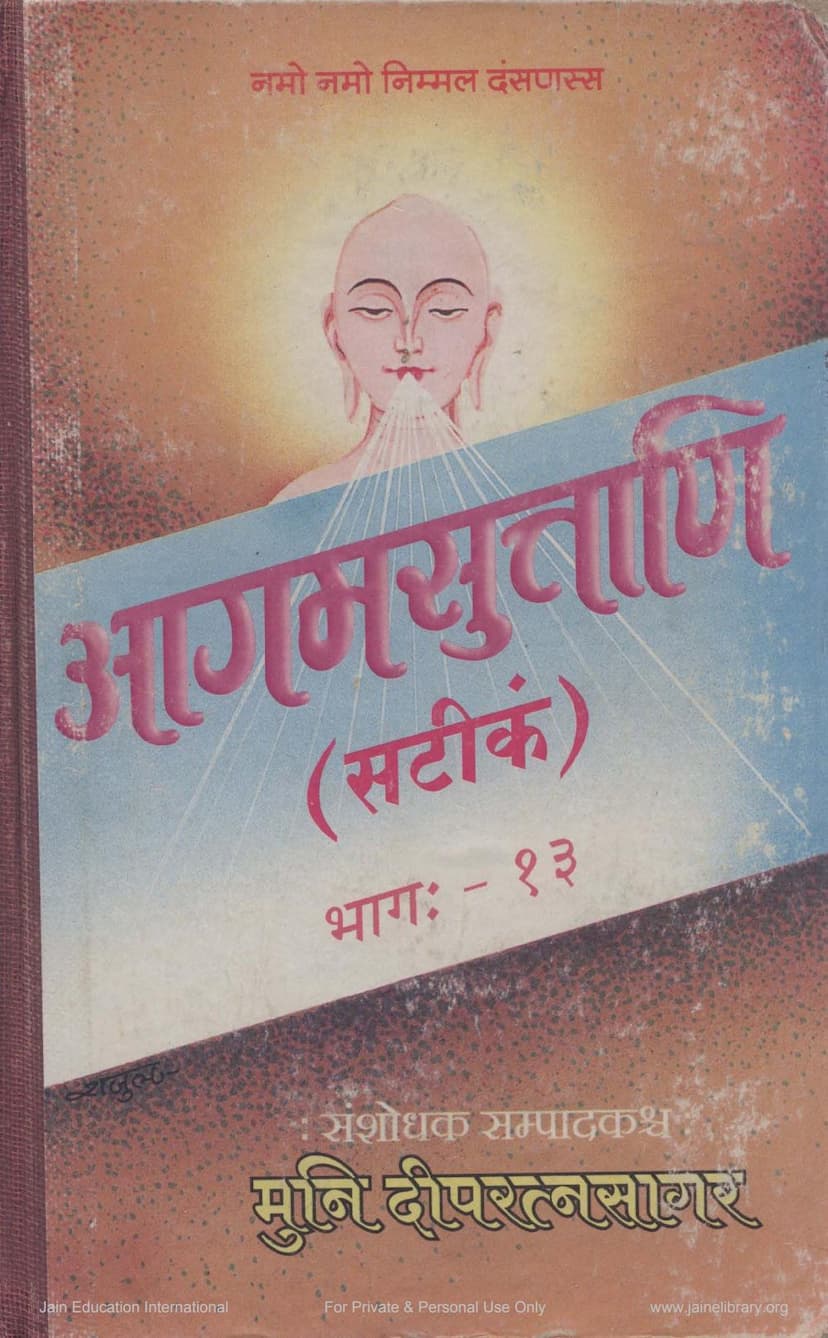Agam Suttani Satikam Part 13 Jambudwip Pragnapati
Added to library: September 1, 2025

Summary
Here's a comprehensive summary in English of the provided Jain text, focusing on the content of the Jambudwip Pragnyapti Upanga Sutra (Part 13 of Agam Suttani Satikam), as presented in the provided pages:
Book Title: Agam Suttani Satikam Part 13: Jambudwip Pragnyapti Author(s): Muni Deepratnasagar, Deepratnasagar Publisher: Agam Shrut Prakashan Catalog Link: https://jainqq.org/explore/003317/1
Overall Purpose:
This text is a commentary (Satik) on the Jambudwip Pragnyapti Upanga Sutra, the seventh Upanga of the Jain Agamas. It aims to explain the profound and intricate details of the Jambudvipa (the central continent in Jain cosmology) as described in the original scripture. The commentary is presented in Gujarati and Hindi, with the original Sanskrit/Prakrit sutras.
Key Contents and Structure (as evident from the Table of Contents and initial pages):
The text systematically explores the Jambudvipa continent, divided into several "Vakshaskara" (chapters or sections). Based on the table of contents (Page #3 and #4), the book covers the following major themes:
-
Vakshaskara 1:
- Jambudvipa's Measurement, Structure, and Form: Details the dimensions, shape, and overall layout of the continent.
- Bharatvarsha: Focuses on the region named Bharatvarsha, its reasons for this name, the city Vinita, the Padmavaravedika (a type of altar or platform), the Cakraratna (the divine wheel, one of the fourteen treasures of a Chakravarti king), its origin, and the six-part journey of a Chakravarti. It also discusses the Magadha region, Prabhasa, and Vardana Tirthas, the fourteen principal Ratnas (gems), their origin and functions, treasures of Bharat Chakravarti, details of gods, kings, armies, villages, and other aspects.
- Mountains and Rivers: Describes the Churva Himavant year-producing mountain, the Padma lake, and the rivers like Ganga and Sindhu flowing from it. It also details the Siddhāyatana (abodes of liberated souls) and other prominent mountains like Nishadha, Nilavanta, and Rukmi.
- Other Regions: Discusses Hemavanta, Harivarsha, Mahavideha, Kuru, and Ramyak areas.
-
Vakshaskara 2:
- Time Cycles (Kala): Explains the concepts of Avasharpini (descending) and Utsarpini (ascending) time cycles and their six phases each (Susama-susama, Susama, Susama-dusama, Dusama-susama, Dusama, Dusama-dusama).
- Cosmic Concepts: Discusses Palyopama and Sagropama (units of time measurement) and Kalpavriksha (wish-fulfilling trees).
- Human Life and Society: Details the lifespan, qualities, and social structure of beings in different regions, including the concept of Kulakaras (progenitors).
- Specific Deeds: Describes activities like the Janmabhishek (birth consecration) of Tirthankaras and the role of Dik-kumari (direction-holding celestial damsels).
- Further Geographical Descriptions: Continues the detailed description of various mountains, rivers, lakes, and other geographical features within Jambudvipa.
-
Vakshaskara 3 & 4 (Inferred from Table of Contents and content):
- Detailed Descriptions of Regions and Features: Continues the detailed geographical and cosmological descriptions, likely focusing on the remaining regions of Jambudvipa (e.g., Mahavideha, Hari, Kuru, etc.) and their associated features like mountains, rivers, cities, forests, palaces, and the celestial beings and inhabitants dwelling there.
- Celestial Bodies: Mentions the description of Chandras (Moon), Suryas (Sun), Nakshatras (Stars), and Taras (constellations).
- Tirthankaras and Significant Figures: Discusses Tirthankaras and other great souls.
- Cosmic Structure: Explains the dimensions, circumferences, and distances of celestial bodies like the Sun and Moon.
Commentary Style:
The commentary by Muni Deepratnasagar is detailed and aims to clarify the original sutras. The presence of terms like "Satik" (with commentary) and "Vrutti" (commentary) indicates a thorough explanation of the original text. The commentary itself seems to be based on earlier works, possibly by Acharya Malayagiri and others, whose works are mentioned as being partially available or interrupted by time's passage. The author notes the difficulty and depth of the subject matter.
Key Jain Concepts Highlighted:
The text delves into core Jain cosmological concepts, including:
- Jambudvipa: The central continent, a microcosm of the Jain universe.
- Lokāloka: The structure of the universe, divided into regions.
- Measurements and Dimensions: Precise (though sometimes immense) measurements of continents, mountains, rivers, oceans, and celestial bodies are crucial in Jain cosmology.
- Time Cycles (Kal Chakra): The cyclical nature of time in Jainism (Avasharpini and Utsarpini).
- Tirthankaras and Siddhāyatanas: Descriptions related to the lives and abodes of Tirthankaras and liberated souls.
- Cosmic Geography: The specific arrangement of continents, oceans, mountains, and rivers, along with their associated deities and inhabitants.
- Śrāvaka and Śramaṇa Dharma: While not explicitly detailed in the provided snippets, the context of Agamas implies the underlying principles of Jain practice.
- Nayas (Perspectives): The introduction suggests an exploration of different philosophical perspectives (like Naya Pramana) to understand the scripture.
Author and Publisher Information:
- Authors: Muni Deepratnasagar, Deepratnasagar (likely the same individual or a collaborative effort).
- Publisher: Agam Shrut Prakashan.
- Editor/Compiler: Muni Deepratnasagar.
Overall Impression:
This is a scholarly work dedicated to elucidating a fundamental text in Jain cosmology. The extensive table of contents indicates a highly detailed and systematic approach to explaining the structure and contents of Jambudvipa, a cornerstone of Jain understanding of the universe. The commentary's purpose is clearly educational, aiming to make complex Agamic knowledge accessible.